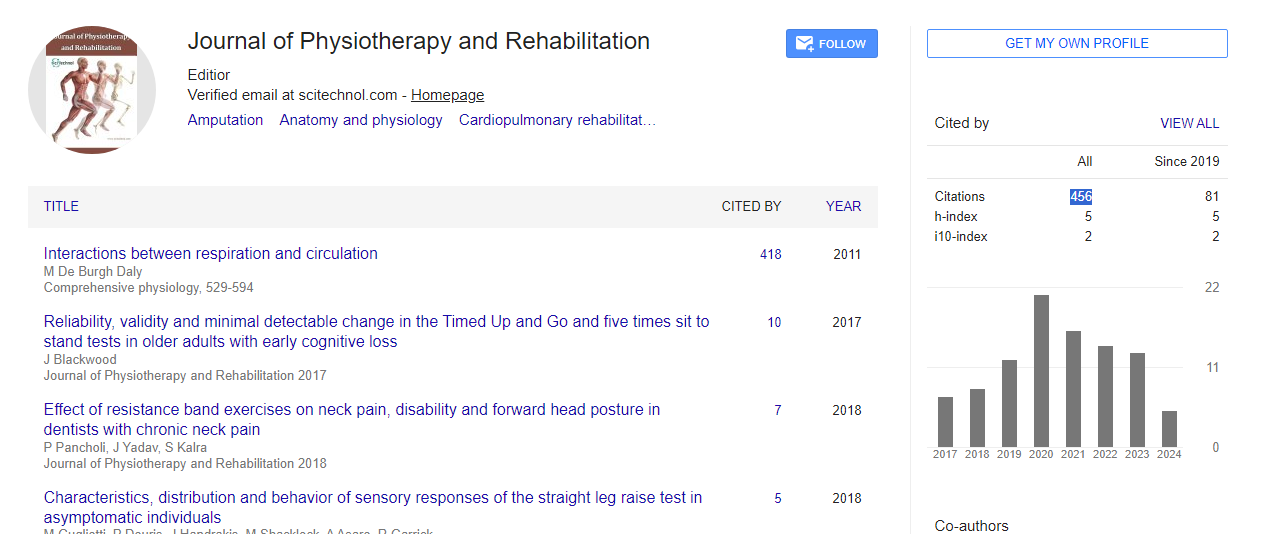Perspective, J Physiother Rehabi Vol: 8 Issue: 2
Advancements in Rehabilitation Strategies for Spinal Cord Injury: Empowering Recovery and Independence
Carla M*
1Department of Physiotherapy, University of Lucerne, Frohburgstrasse 3, 6002 Lucerne, Switzerland
*Corresponding Author: Carla M,
Department of Physiotherapy, University of
Lucerne, Frohburgstrasse 3, 6002 Lucerne, Switzerland
E-mail: mcar@la.sw
Received date: 27 March, 2024, Manuscript No. JPTR-24-135085
Editor assigned date: 29 March, 2024, PreQC No. JPTR-24-135085 (PQ);
Reviewed date: 12 April, 2024, QC No. JPTR-24-135085
Revised date: 19 April, 2024, Manuscript No. JPTR-24-135085 (R);
Published date: 29 April, 2024, DOI: 10.4172/JPTR.1000169.
Citation: Carla M (2024) Advancements in Rehabilitation Strategies for Spinal Cord Injury: Empowering Recovery and Independence. J Physiother Rehab 8:2.
Description
Spinal Cord Injury (SCI) is a devastating condition that affects millions of individuals worldwide, profoundly impacting their mobility, sensation, and overall quality of life. While a spinal cord injury can be life-altering, advancements in medical science and rehabilitation strategies offer hope for enhanced recovery and improved outcomes. In this article, we delve into the latest rehabilitation strategies for spinal cord injury, focusing on empowering individuals to regain independence and lead fulfilling lives.
The spinal cord serves as a vital pathway for transmitting signals between the brain and the rest of the body. When the spinal cord is injured, communication between the brain and various parts of the body is disrupted, leading to paralysis or loss of sensation below the level of injury. Spinal cord injuries are classified as either complete, where there is a total loss of function below the injury site, or incomplete, where some function remains.
The primary goals of rehabilitation for spinal cord injury are to maximize functional independence, enhance quality of life, and prevent secondary complications such as muscle atrophy, pressure sores, and respiratory problems. Rehabilitation begins as soon as possible after injury and is often a lifelong process aimed at optimizing physical, psychological, and social well-being.
Effective rehabilitation requires a multidisciplinary team consisting of physicians, physical therapists, occupational therapists, speech therapists, psychologists, social workers, and other specialists. This team collaborates to address the diverse needs of individuals with spinal cord injury, tailoring treatment plans to meet their specific goals and challenges.
Physical therapy plays a central role in spinal cord injury rehabilitation, focusing on strengthening muscles, improving range of motion, and enhancing mobility. Therapeutic exercises, assistive devices, and functional electrical stimulation may be used to facilitate movement and promote recovery. Intensive locomotor training, such as body-weight-supported treadmill training, has shown promise in helping individuals with incomplete spinal cord injuries regain walking ability.
Occupational therapists assist individuals with spinal cord injury in relearning activities of daily living, such as dressing, grooming, and cooking, to promote independence and self-care skills. They may recommend adaptive equipment and environmental modifications to facilitate participation in meaningful activities and promote community integration
Speech therapists address communication and swallowing difficulties that may arise following spinal cord injury, providing interventions to improve speech clarity, language expression, and swallowing function. Augmentative and alternative communication devices may be utilized to facilitate communication for individuals with severe speech impairments.
Psychological support is essential for individuals coping with the psychological and emotional challenges associated with spinal cord injury, including grief, depression, anxiety, and adjustment to disability. Psychologists and counselors offer counseling, cognitivebehavioral therapy, and support groups to help individuals develop coping strategies, enhance self-esteem, and advance flexibility.
Advancements in technology have revolutionized spinal cord injury rehabilitation, offering new avenues for recovery and independence. Powered exoskeletons, robotic assistive devices, and neuroprosthetic implants hold promise in restoring mobility and function for individuals with spinal cord injury. Virtual reality and gaming-based interventions provide engaging platforms for rehabilitation exercises and functional training.
Reintegration into the community is a important aspect of spinal cord injury rehabilitation, empowering individuals to participate in social, vocational, and recreational activities. Vocational rehabilitation programs assist individuals in returning to work or pursuing educational and career goals, fostering financial independence and societal inclusion.
Conclusion
Rehabilitation strategies for spinal cord injury continue to evolve, driven by advancements in medical science, technology, and rehabilitation practices. By employing a multidisciplinary approach and leveraging innovative interventions, individuals with spinal cord injury can achieve remarkable gains in function, independence, and quality of life. While the journey of recovery may be challenging, with perseverance, support, and access to comprehensive rehabilitation services, individuals with spinal cord injury can overcome obstacles and thrive in their pursuit of a fulfilling life.
 Spanish
Spanish  Chinese
Chinese  Russian
Russian  German
German  French
French  Japanese
Japanese  Portuguese
Portuguese  Hindi
Hindi 